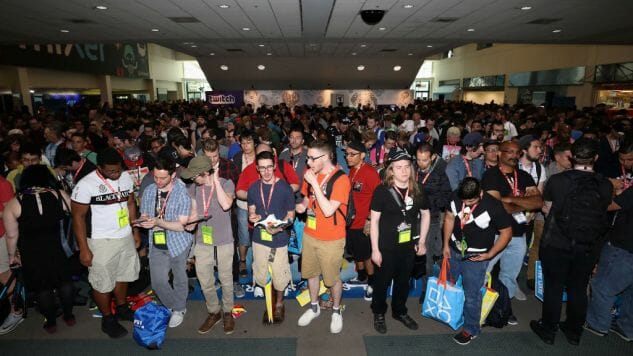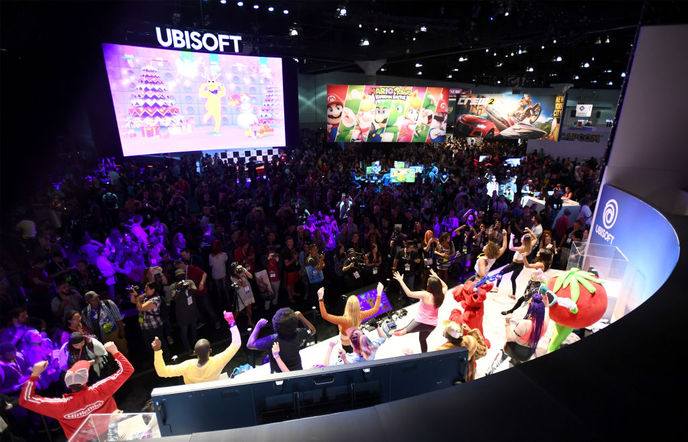E3 Is Too Crowded Now (And That Sucks)
The Public Is Taking Over What Is Traditionally a Professional Event
Photos courtesy of Getty Images Games Features E3 2017
If you follow any videogame journalists on social media, you’re probably aware that E3 2017 is an overpacked shitfest. The lines, which have always been long, have taken on a new, final boss form that makes the years past look tranquil by comparison. This year, the ESA decided to open up admission to the public—a not entirely new move, given the limited, and expensive, tickets available to fans in the past. But whereas once the scarcity and cost created a reasonable barrier to entry, now the floodgates have opened. In fact the Electronic Software Association claims to have sold 15,000 general admission tickets while scaling back admittance for media and press. While it may be “good” for the show’s future in terms of finances, the question remains: is this really good for the health of the show?
As an illustration of how much bigger the E3 crowd is this year, consider the lines leading up to the front doors before the show opens in the morning. In the past, these never extended beyond the convention center entry. When I took a cab up to South Hall an hour before the show started on Tuesday morning, the throngs were so thick they had extended all the way to the edge of the sidewalk, with almost no way to get through. South Hall typically was the emptier of the two, despite its reputation as “the” place for the larger, showier booths with statues and garish displays. Are the booths in South Hall like that this year? Hard to say. I couldn’t get close enough to tell. My E3 log last year remarked that it was easy to get pictures with the show floor so empty. E3 2017 seems to be an overcompensation.
Amid the chaos Tuesday, I managed to get in some time in with Call of Duty WWII and Destiny 2, but only because I had an appointment—the open demo areas for Destiny 2 were flooded and shut down literally within 3 minutes of the show opening, while most of the attendees had yet to even make it through the sliding glass doors at the bottom of South Hall’s escalators. According to Polygon, the ESA even opened up the show floor fifteen minutes early to “avoid a hazard,” but you could have fooled me. At thirty minutes past the show floor’s official opening, there were still people in line filtering in, and no one could easily move through the hallways, due to clusters of gawking fans and socializing game execs who, for whatever reason, felt compelled to stop wherever they are and force people to shuffle around them.
So exactly what is the plan here, ESA? I can’t imagine fans will want to return if they can’t even get in to see the games they like. One of my friends gave up before even getting inside. And journalists are starting to figure out that they can cover the show just as well from home as they can from LA. So what future is there, really? Will E3 just be another PAX? Because PAX West is in my hometown within walking distance and it’s only two months after E3. It feels like there are more effective ways of spending my time and money and I can’t imagine fans won’t feel the same after this experience.
Thinking back to PAX, I wonder if overcrowding will ever be an issue that convention centers can adequately solve. Booths are expensive endeavors that the big publishers have no problem affording, and yet there are never enough demo stations. And even if there were, who could possibly anticipate the demand? It’s almost impossible to gauge pre-release interest well enough to predict booth attendance numbers. PAX has always been subject to immediate sell-out status whenever tickets are posted, and I remember the days of watching my friends on Twitter lament the instant scarcity. This has diminished only slightly since more shows (Boston, Australia, Texas) were added. Can the demand from fans ever be satiated? Why does this happen with videogames? Have we established the medium as such an escapist fantasy that their enthusiasm is inescapably intense? Where does the demand end—when they’ve become jaded and cynical after being deceived by demos and trailers too many times? Welcome to being a game journalist, I guess.
Which is better, publishers? Disappointing your fans through a journalist proxy, or doing it directly yourselves by offering demos and trailers that will inevitably be a let-down from the real thing? As a journalist in tech, my job frequently takes on the role of consumer advocacy. Often it’s only us standing between a fan and a bad game. It’s a thankless task, often vilified by those who have idealized the unique access we’re allowed to devs and publishers. Are you sure you don’t want to use us as a buffer? At least when we’re the ones delivering the bad news, the fans have someone to blame other than you.
What is the future of E3? From where I’m sitting, it’s headed towards a fan convention, and the world already has enough PAXes. E3 also holds enormous appeal to those outside the industry specifically because of the special access the event affords. With that element removed, it’s possible that fan interest will drop off anyway. If the ESA wishes to maintain the professional relevancy of E3, they need to scale back the public attendance (reduce available general admission tickets) so that the people who have a job to do can, ahem, do their job.
Can this happen in an industry that has built itself on hype, dreams and unfulfilled promises, where fan enthusiasm will always outpace caution and prudent skepticism? Only time will tell. But my guess is it can’t.
Holly Green is the assistant editor of Paste Games and a reporter and semiprofessional photographer. She is also the author of Fry Scores: An Unofficial Guide To Video Game Grub. You can find her work at Gamasutra, Polygon, Unwinnable, and other videogame news publications.
